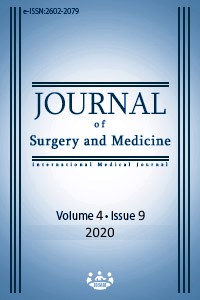Effectiveness and safety of using a novel endothelial damage inhibitor in arteriovenous fistula formation
Keywords:
End stage renal disease, Arteriovenous fistula, Endothelial protection solution, Patency rateAbstract
Aim: Patients with end-stage renal disease need accurate and effective vascular access for hemodialysis. Although renal transplantation is the golden standard treatment that provides a life without hemodialysis, an arteriovenous (AV) fistula is the most frequent method for sustaining long-term hemodialysis because of insufficient renal donors. In the current study, we aimed to compare patency rates of AV fistulae created with or without the endothelial protection solution. Methods: This single-center case-control study was conducted between August 2018 and August 2019. Patients with end-stage renal disease requiring AV fistula access for hemodialysis (n= 49) were included in the study and divided into two groups. During the creation of an AV fistulae, endothelial protection solution was used in 27 patients, who constituted Group A, and not used in 22 patients, who were included in Group B (the control group). All fistulae anastomoses were performed by the same surgical team. The demographical data, maturation time, mean flow volume, complications, basal metabolism index (BMI), and patency rates at the 3rd and 6th months were compared. Results: There was no significant difference between the two groups regarding demographical findings (p>0.05). The patency rates were higher in group A at both the 3rd and 6th months (96% and 93%) when compared with group B (64% and 27%) (P<0.05). Conclusion: AV fistulae created with endothelial protection solution has higher patency rates compared to conventionally created AV fistulae.
Downloads
References
III. NKF-K/DOQI Clinical Practice Guidelines for Vascular Access: update 2000. Am J Kidney Dis. 2001; 37(Suppl 1):S137–81.
Allon M. Current management of vascular access. Clin J Am Soc Nephrol. 2007;2:786–800. https://doi. org/10.2215/CJN.00860207 PMID: 17699495
I. NKF-K/DOQI Clinical Practice Guidelines for Hemodialysis Adequacy: Update 2000. Am J Kidney Dis 2001; 37(Suppl. 1):S137eS181
RiellaMC, Roy-Chaudhury P. Vascular access in haemodialysis: strengthening the Achilles’ heel. Nat Rev Nephrol. 2013;9(6):348-57.
Viecelli AK, Mori TA, Roy-Chaudhury P, Polkinghorne KR, Hawley CM, Johnson DW, et al. The pathogenesis of hemodialysis vascular access failure and systemic therapies for its prevention: Optimism unfulfilled. Semin Dial. 2018 May;31(3):244-57.
Simon E, Long B, Johnston K, Summers S.A Case of Brachiocephalic Fistula Steal and the Emergency Physician's Approach to Hemodialysis Arteriovenous Fistula Complications. J Emerg Med. 2017;53(1):66-72.
Ben Ali W, Voisine P, Olsen PS, Jeanmart H, Noiseux N, Goeken T, et al. DuraGraft vascular conduit preservation solution in patients undergoing coronary artery bypass grafting: rationale and design of a within-patient randomisedmulticentre trial. Open Heart. 2018;5(1):e000780. Published 2018 Apr 13. doi: 10.1136/openhrt-2018-000780
Caliskan, E., Sandner, S., Misfeld, M, Aramendi J, Salzberg SP, Choi YH, et al. A novel endothelial damage inhibitor for the treatment of vascular conduits in coronary artery bypass grafting: protocol and rationale for the European, multicentre, prospective, observational DuraGraft registry. J Cardiothorac Surg. 2019;14(1):174. https://doi.org/10.1186/s13019-019-1010-z
Fitts MK, Pike DB, Anderson K, Shiu YT. Hemodynamic Shear Stress and Endothelial Dysfunction in Hemodialysis Access. Open Urol Nephrol J. 2014;7(Suppl 1 M5):33-44. doi: 10.2174/1874303X01407010033
Brahmbhatt A, Remuzzi A, Franzoni M, Misra S. The molecular mechanisms of hemodialysis vascular access failure. Kidney Int. 2016;89(2):303-16. doi: 10.1016/j.kint.2015.12.019
Siddiqui MA, Ashraff S, Santos D, Carline T. An overview of AVF maturation and endothelial dysfunction in an advanced renal failure. Renal Replacement Therapy. 2017;3:42.
de Vries MR, Simons KH, Jukema JW, Braun J, Quax PH. Vein graft failure: from pathophysiology to clinical outcomes. Nat Rev Cardiol. 2016;13(8):451–70.
Cavallari N, Abebe W, Mingoli A, Sapienza P, Hunter WJ3rd, Agrawal DK, et al. Short-term preservation of autologous vein grafts: effectiveness of University of Wisconsin solution, Surgery. 1997;121:64-71.
Shuhaiber JH, Evans AN, Massad MG, Geha AS. Mechanisms and future directions for prevention of vein graft failure in coronary bypass surgery, European Journal of Cardio-Thoracic Surgery. 2002;22(3):387–96.
Haime M, McLean RR, Kurgansky KE, Emmert MY, Kosik N, Nelson C, et al. Relationship between intra-operative vein graft treatment with DuraGraft(R) or saline and clinical outcomes after coronary artery bypass grafting. Expert Rev Cardiovasc Ther. 2018;16(12):963–70.
Mochizuki S, Vink H, Hiramatsu O, Kajita T, Shigeto F, Spaan JA, et al. Role of hyaluronic acid glycosaminoglycans in shear-induced endothelium-derived nitric oxide release. Am J Physiol Heart Circ Physiol. 2003;285(2):H722-6.
Lennon FE and Singleton PA. Hyaluronan regulation of vascular integrity. Am J Cardiovasc Dis 2011;1(3):200-13.
Bahcivan M, Yucel S, Kefeli M, Gol MK, Can B, Keceligil HT. Inhibition of vein graft intimal hyperplasia by periadventitial application of hyaluronic acid-carboxymethyl cellulose: an experimental study. Scand Cardiovasc J. 2008;42(2):161-5.
Downloads
- 516 920
Published
Issue
Section
How to Cite
License
Copyright (c) 2020 Emced Khalil, Çağrı Akalın
This work is licensed under a Creative Commons Attribution-NonCommercial-NoDerivatives 4.0 International License.
















